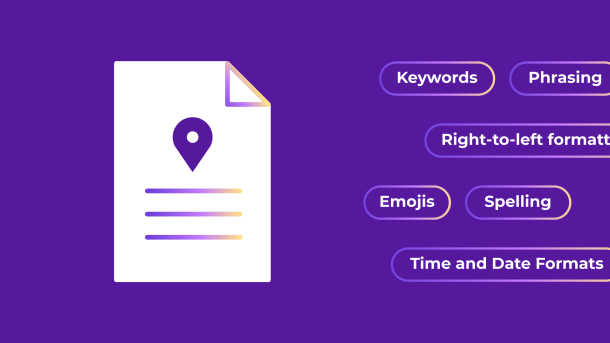“While they may want the products or experiences on [an] English-language site, most [consumers] would rather think, act, and buy in their own language.” These are the words of Dr. Donald DePalma, CSA Research’s Founder and Chief Strategy Officer, regarding consumer research done by CSA.
The findings suggest that failing to localize your buying experience could cost you 40% or more of your total addressable market. That price is too high to pay for most businesses, which underscores the importance of localization—especially content localization.
Content is an integral part of the modern buying experience, with B2B buyers consuming at least 13 pieces of content before deciding on a vendor. And B2C buyers consume several pieces as well. Whether your company is B2B or B2C, here’s how to retain as much of your total addressable market as possible.
What is content localization?
Content localization is adapting and transforming content, so it resonates in another country or locale. While it often involves translating text from one language to another, its focus is much broader.
Localization makes content feel “local” by acknowledging cultural and country-specific nuances. It can include making any or all the following changes:
- Spelling: Language variants often have slightly different spelling of words. For example, you’d need to change “localization” to “localisation” when localizing content for an audience in the United Kingdom.
- Phrasing: This is especially critical with content that may seem culturally insensitive or out of place to the intended audience. Humor and slang, in particular, may not translate well into other languages.
- Keywords: If search engine optimization (SEO) is part of your content marketing strategy, you’ll need to conduct fresh keyword research and use target search terms common to the local area in their language.
- Time and date formatting: Different countries have different time and date format preferences. Does the local audience in your target region use MM/DD/YYYY or DD/MM/YYYY, or the 12 or 24-hour clock?
- Measurements: The imperial and metric systems apply to length and distance, weight, volume, and temperature. The measurement types you should use (e.g. miles or kilometers) depend on your target region.
- Hyperlinks: When translating content into another language, find source material to link to in the target audience’s native language. Say a piece of your content links to a news article on a recent industry development. The localized version should link to a similar article from an industry publication in the target language.
- Images: You may need to swap locale- or culture-specific images with others that speak to your new audience. These might show local areas and landmarks or people that are part of the culture you’re tailoring your content to.
- Emojis: It’s important to use emojis in the same way the local audience does, since their meanings can vary across cultures. For example, the smiley face that symbolizes happiness and kindness in the US and UK symbolizes mistrust and contempt in China.
- Right-to-left formatting: Layout adjustment is necessary when localizing content into right-to-left languages like Arabic and Hebrew, for instance.
How content localization is different from translation
In short, translation is one step of the localization process.
Most translators consider localization issues when translating text. Yet, their focus is straightforward—converting the words on the page into another language. They work to respect the target language’s grammar rules and syntax, while faithfully conveying the meaning of the original text.
Then, localization solves the technical and cultural challenges of transforming a company’s content for a new audience. It’s what gives a translation a native feel.
What is content localization software?
Content localization software supports the translation process by automating workflows and centralizing the translation process.
Businesses rely on these software solutions to seamlessly scale their translation and localization management efforts as they expand into additional domestic and international markets. Further, linguists look to them to handle language localization's manual and technical aspects. This frees them up to concentrate on what they do best: translating a company’s words.
Word order: An example of a common web localization challenge
Localization often requires changing the order of words, phrases, or content. That means that dynamic content—content that varies based on data and individual users—must also shift. This is true even when such content shouldn’t be translated.
Smartling’s translation and localization software transforms that dynamic content into placeholders like the following:
Welcome %{username}, you have $%{balance} in your account.
Translators can then move placeholders wherever they’re needed in the translated string without having to do any coding themselves.
HTML and formatting tags, such as bold text or line breaks, can also be represented simply and cleanly. They can be inserted into the target text without the risk of technical or rendering issues upon publishing the localized content.
The benefits of using a localization content management system
Using software to manage your localization needs puts you in control of your translation workflows and processes. They allow you to do the following:
- Automate and customize your workflows
- Easily access and search your linguistic assets, such as your translation memories, style guides, and glossaries
- Preview a web page or other piece of content thanks to visual context provided within the translation management system
- Reduce the risk of human error through quality checks
- Keep communication between project managers and linguists centralized within the platform
Ultimately, these functionalities help businesses and translators reduce the time spent on repetitive, manual tasks. Not to mention that they can simultaneously boost quality as well.
What content should you use localization software to translate?
The short answer is any and all content.
Website, software, and mobile app localization needs may seem like the top priority. Yet, those are only the tip of the iceberg. Your company interacts with customers through an array of channels and content. To successfully connect with new local markets, everything requires localization—from product packaging and marketing materials to emails and social media outreach.
Hence the reason content localization software is so valuable. It can help you manage the translation process for each content type seamlessly and at scale.
When should you localize your content?
We’ve established that you should localize your content. Now, let’s get into some indicators that it’s time to start:
- Your website brings in a lot of traffic from other countries, meaning there’s demand in those regions. If very few of those visitors currently become customers, content localization would change that.
- You get requests for content in different languages. Patterns in such requests from potential or current customers will give you a good idea of where to start with localization.
- Your competitors are expanding into foreign markets and investing in localization. This is a sign of untapped opportunities, so staying on par with the competition—if not outpacing them—is crucial.
But that’s not all. While sharing with us her experience helping companies expand into new geographies, marketer Dana Cass pointed to another important indicator. Dana, the founder of Cass Content Studios, said:
“Companies should invest in localization when they’re actively going to market (e.g., when a local salesperson is on the ground driving deals). [Specifically, when they’re doing so in a locale] where having culturally-appropriate content is necessary to be taken seriously.
You can get away with American English for a while when you're selling enterprise software in the UK or Canada. However, you're not going to make much progress in France or Japan without localized content.”
This covers when to start, but there’s also the matter of what to localize first.
Prioritizing content to maximize the impact of localization efforts
Dana recommends starting with “the minimum set of marketing content you need to sell your product” first. What might that set of content include? Potentially, the bottom-of-the-funnel (BOFU) content that generates the most revenue—as long as your target market is well-informed and/or your call-to-action is relatively low pressure.
For instance, to start, you could safely localize just your BOFU pages into UK English from US English. This is because the target audience could still understand the top- and middle-of-the-funnel content that would lead them to those BOFU pieces and the point of purchase. But the same wouldn’t be true if you were breaking into the Mexican market and localizing only your BOFU content into Spanish.
In such a case, it’d be better to localize the highest-value content from each stage of your marketing funnel or the user journey through your site. This would mirror the usual customer journey, helping you progressively prepare your new international audience to convert.
Beyond this, the following are among the more important types of content to localize:
- Legal documentation and policies
- Evergreen content or content with a longer shelf-life (as opposed to news or trend-based content)
- Copy for upcoming marketing campaigns
- Customer support content to provide a good customer experience and retain customers
How to measure the success of localized content
Once you work through the content localization process, how do you know if your efforts have been worthwhile?
The first step to gauging success is quality assurance. Double-check that your messaging is coherent from a translation standpoint and, equally importantly, that the thorough local and cultural research you’ve done shines through. You’ll likely receive feedback on both aspects of quality from your audience at some point. However, proactivity is also important. Develop a process for gathering qualitative feedback from native speakers and local experts during the localization process.
As for measuring quantitative success, don’t blindly use the same metrics you do in your core market. New markets often call for new key performance indicators (KPIs).
To illustrate, within the domestic market, an established business might view conversion rate as its most important metric. But that may not be a good initial metric to track if the company expands into a new market. Until it earns more local attention and trust, it would be smart to set goals related to brand visibility, awareness, or engagement.
The fundamentals of measuring the success of localized content are similar to how you already evaluate performance. But your original content shouldn’t be the yardstick by which you judge localized versions of it. Decide on KPIs, set goals, and track results as you would if you were starting from scratch.
All that’s left now is to get started.
About Smartling
Smartling’s website translation software has a range of utilities to aid in your localization efforts. Our translation software has native integrations for the most popular ecommerce platforms, content management systems, help desk portals, marketing hubs, and repositories to make localization effortless. And we have a team of talented translators from all over the world to provide accurate translations in any language.
Ready to learn more? Contact us to get started.
Looking to do more research? Download our Sample Translation RFP to define your goals and focus your search.

.jpg)




